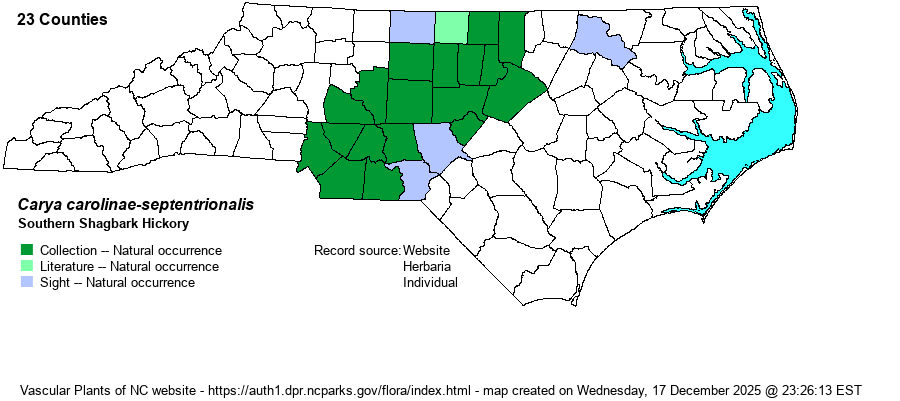| Section 6 » Order Juglandales » Family Juglandaceae |
Show/Hide Synonym
| taxonName | relationship | relatedTaxonName | relatedTaxonRefText | relComments |
|---|
|
|
|
|
|
|
|
| Carya carolinae-septentrionalis | = | Carya ovata var. australis | Flora of North America (1993b, 1997, 2000, 2002a, 2002b, 2003a, 2004b, 2005, 2006a, 2006b, 2006c, 2007a, 2009, 2010) | | | Carya carolinae-septentrionalis | = | Hicoria carolinae-septentrionalis | Small (1933, 1938) | | | Carya carolinae-septentrionalis | = | Carya ovata var. carolinae-septentrionalis | | | | Carya carolinae-septentrionalis | = | Carya australis | | | | Source: Weakley's Flora |
|
| Author | (Ashe) Engler & Graebner | |
| Distribution | A narrow northeast-southwest band, though the eastern 50% of the Piedmont; west to Rockingham, Davidson, and Mecklenburg counties. Apparently no legitimate records from the Mountains or the Coastal Plain, and quite scarce in the northeastern corner of the Piedmont.
The species has separate ranges – essentially in the Piedmont from extreme southern VA to central GA; and from southern KY to southern AL and MS. Scarce in the Appalachians, if present at all.
| |
| Abundance | Infrequent to fairly common within its narrow range. It is most frequent and widespread in parts of the Uwharrie Mountains, particularly those composed of mafic rocks (mainly those in the southwestern half of that range). | |
| Habitat | This species favors dry upland hardwood forests, usually on flats or gentle slopes, but also can be found on ridgetops and monadnocks. It is normally found on somewhat circumneutral soil. Unlike the similar Shagbark Hickory (C. ovata), it is scarce in bottomland forests and on rich lower slopes – both species do favor circumneutral soils – but at times the two species can and do occur close to each other. |
| Phenology | Flowers in April and May, and fruits in October. | |
| Identification | Many biologists are unfamiliar with this medium to large deciduous tree, which grows to 80 feet or more. Like Shagbark Hickory, it has very shaggy, gray bark, which should separate it from all other NC trees except that species and the very rare Shellbark Hickory (C. laciniosa). Like Shagbark Hickory, it has 5-7, usually just 5, leaflets. However, Southern Shagbark Hickory has narrower leaflets that are lanceolate or oblanceolate, about 5 inches long but about 2 inches wide. Also, this species has slender twigs, the young ones being only 1-3 mm across, and are reddish-brown to blackish in color, with small buds. Shagbark Hickory is a more robust species – larger and wider leaflets, thicker twigs, and large buds. | |
| Taxonomic Comments | Most references, particularly those whose authors live within the range of this taxon, consider it a valid species, separate from Shagbark Hickory. RAB (1968) and Weakley (2018), for example, whose authors have spent much time in NC, consider the two as separate, as does NatureServe, which even has no dreaded “Q” [questionable taxonomy] rank. However, some – probably incorrectly – still consider this taxon as a variety, as C. ovata var. carolinae-septentrionalis, or as C. ovata var. australis. Weakley (2018) gives reasons for it being a good species.
| |
| Other Common Name(s) | Carolina Shagbark Hickory, Carolina Hickory | |
| State Rank | S3 | |
| Global Rank | G5? | |
| State Status | | |
| US Status | | |
| USACE-agcp | | |
| USACE-emp | | |

